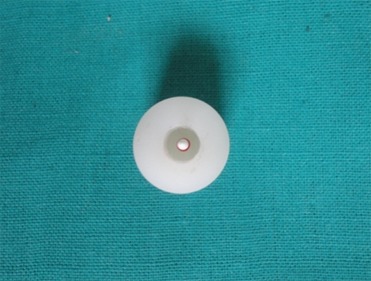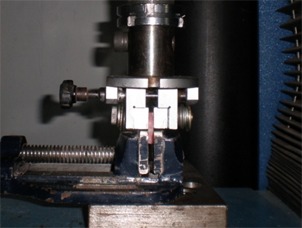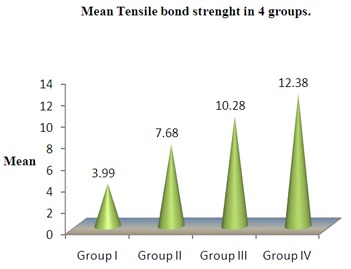Abstract
Background: Fiber posts are widely used for restoration of mutilated teeth that lack adequate coronal tooth structure to retain a core for definitive restoration, bond between the fiber post and composite material depends upon the chemical reaction between the post surface and the resin material used for building up the core. In attempt to maximize the resin bonding with fiber post, different post surface conditioning is advocated. Therefore the purpose of the study is to examine the interfacial strength between fiber post and composite, as core build-up material after different surface treatments of fiber posts.
Materials & Methods:Twenty fiber posts were split into four groups off five each according to different surface treatments viz. Group I-(Negative Control), Group II-Silanization (Positive control), Group III-(37% Phosphoric Acid & Silanization) ,Group IV- (10% Hydrogen Peroxide and Silanization). With the preformed plastic mould, a core of dual cure composite resin around the fiber post having the uniform thickness was created. Tensile bond strength of each specimen was measured under Universal Testing Machine (UTM) at the cross head speed of 3mm/min.
Results: The results achieved with 10% Hydrogen peroxide had a marked effect on micro tensile bond strength values between the tested materials.
Conclusion: Immense enhancement in the silanization efficiency of quartz fiber phase was observed with different surface chemical treatment of the resin phase of fiber posts with the marked increase in the micro-tensile bond strength between fiber post and composite core.
How to cite this article: Shori D, Pandey S, Kubde R, Rathod Y, Atara R, Rathi S. To evaluate and compare the effect of different Post Surface treatments on the Tensile Bond Strength between Fiber Posts and Composite Resin. J Int Oral Health 2013; 5(5):27-32.
Key Words: : Fiber post, Micro-tensile bond strength, Silanization, Surface treatment
Introduction
Fiber posts are widely used to retain a core for permanent restoration in those endodonticaly treated teeth that do not have sufficient coronal tooth structure.1 Many invitro studies have investigated factors that may affect the retention of a post, which
may include design, length, diameter and surface treatments.2 Chemical interaction that forms the bond between fiber post and core is not sufficient enough to withstand the occlusal stresses, surface pre-treatment of fiber post is the common method employed to improve the adhesion property of material.1
Chemical interaction between the fiber post surface and the composite can only ensure the bond at the post-core interfacial level. Several surface treatments have been suggested in order to increase the present bonding with fiber post. These procedures fall into three categories: 1) Coating with priming solutions i.e. Treatments that result in chemical bonding between a composite and post; 2) Sand blasting and Etching i.e. Treatments that intend to roughen the post surface or 3) Combination of micro-mechanical and chemical components either by using the above mentioned two methods or a unique system {such as Co-Jet}.3
Objective of this study was to investigate the tensile bond strength between resin based fiber posts and composite core build up material before and after silanization and to verify the same after treatment with 10% Hydrogen Peroxide & 37% phosphoric Acid before silanization.
Materials & Methods
Twenty fiber posts (FIBRAPOST PLUS-Produits Dentaires SA Vevey-Switzerland) of diameter 1.7mm were used in this study. According to different
chemical treatments on post surface groups were divided:
Group-I (Negative Control) – No Treatment.
Group-II (Positive Control) - Silane Coupling Agent was applied on the surface of the post for 60 seconds.
Group-III - Surface of the post was etched with 37% Phosphoric Acid for 15 seconds and then Silane coupling agent was applied for 60 seconds.
Group-IV - Surface of the post was etched with 10% Hydrogen peroxide for 10 minutes and then Silane coupling agent was applied for 60 seconds.
The plastic mould having 6mm diameter and 10mm height was used. Each post was positioned perpendicularly in middle of the circular plastic mould (Fig.1) and core was built up using dual cure composite core material (Multi-core Flow –Ivoclar-Vivadent-Liechenstein). Each increment of 2mm composite was cured for 40 seconds with a light emitting diode. The material was directly polymerised from the upper orifice of the mould. The polymerised
Fig. 1: Plastic mould with post positioned perpendicularly in the centre.

composite with post in the center was subsequently removed from the mould after filling it completely. This resulted in a circular core of resin composite that was built around the fiber post (Fig.2).
Fig. 2: A circular core of resin composite that was built up around the fibre post after surface treatment.

After storing each bonded specimen in distilled water for 24hours, they were mounted on the acrylic block. Each core was then horizontally sectioned to obtain two beams (2mm each in thickness). Each beam was then securely held between the two metal jigs attached to the UTM, producing tensile forces having the cross head speed of 3mm/min until the fracture occured between fiber post and composite core (Fig.3). The tensile bond strength of each sample was calculated: (Force at Failure / Bonded cross sectional surface area), expressed in Mpa.4
Fig. 3: Application of tensile load in universal testing machine.

Results
The results of the mean and median micro-tensile bond strength values of all the groups were calculated [Table 1, Graph-I]. Group-IV showed maximum bond strength values (12.43 Mpa), which was higher than Group-III, Group-II and Group-I i.e. 10.28 Mpa, 7.68 Mpa & 3.99 Mpa respectively. The values were statistically analysed using two-way Anova & Bonferroni Test. In multiple comparison test (Table 2) all the individual experimental groups showed significant difference (P<0.0001).
Table 1: Mean and Median values of Tensile bond strength in 4 groups.neway ANOVA.
| SN | Group I | Group II | Group III | Group IV |
| Mean | 3.99 | 7.68 | 10.28 | 12.38 |
| S.D | 0.57 | 1.02 | 1.91 | 1.31 |
| Median | 3.87 | 7.79 | 9.98 | 12.65 |
| F-statistics | 132.88 | |||
| p-value | P<0.0001, Highly significant. | |||
Graph 1: Bar diagram showing mean and Median values of Tensile bond strength in all 4 groups.

Table 2: Multiple comparison of Mean Tensile Bond strength in 4 groups. onferroni Test.).
| Comparison | Mean difference | p-value | significance |
| Group I Vs Group II | 3.68 | P<0.001 | Highly significant |
| Group I Vs Group III | 6.28 | P<0.001 | Highly significant |
| Group I Vs Group IV | 8.38 | P<0.001 | Highly significant |
| Group II Vs Group III | 2.59 | P<0.001 | Highly significant |
| Group II Vs Group IV | 4.7 | P<0.001 | Highly significant |
| Group III Vs Group IV | 2.10 | P<0.001 | Highly significant |
Discussion
When esthetic is of prime concern, fiber posts are better than metal posts as these light coloured posts are having the added advantages of translucency.5 The bond between the fiber posts and core does not have sufficient strength to withstand the occlusal stresses. Hence the surface pre-treatment of fiber post has been commonly used to enhance the adhesive property of the material. It has been suggested that with the use of chemical surface treatments the tensile bond strength between fiber posts and core build up materials increases immensely.
Silane coupling agents are hybrids of organic-inorganic compounds that arbitrate adhesion between organic and inorganic matrices by an intrinsic dual reactivity.6 Goracci-etal in their study measured the adhesion between different types of fiber posts and flowable composites after silanization and found increased effect on adhesion of post and core system. Since MPS (3-trimethoxy silylpropylmethacrylate) silane does not bond properly with the epoxy matrix, which results in a weak bond strength between resin phase of the fiber posts and the methacrylate-based resin composite.3,6,7,8,9
Phosphoric acid has been commonly used in different concentrations ranging from 30%-50% for the process of acid etching of different materials. In this study, Phosphoric acid (37%) was used as post surface conditioner, which is preferred for acid etching of the tooth surface.10 Sandra C.Zamboni etal studied the
fatigue resistance in bovine teeth after post surface conditioning with Phosphoric acid (37%) or Tribo-chemical silica and reported no difference between the two , as all the specimens survived fatigue testing.11
The etching effect of Hydrogen-peroxide depends on its capability to dissolve the resin matrix partially, thereby breaking the epoxy resin bonds through the mechanism of substrate oxidation. The same etching procedure is employed to improve the micro-mechanical retention between the epoxy resin matrix of fiber post and methacrylate based resin composites.12,13,14,15 By removing the superficial layer of epoxy resin through chemical treatment more surface area of exposed quartz fibers becomes available for reacting with the molecules of silane. Thus after etching and rinsing of post surface, large active surface of exposed quartz fibers is available for both chemical and micro-mechanical retention.12 Studies performed by Francesca Monticelli etal. and Mylswamy Sumitha etal with 10% Hydroen Peroxide showed increased micro-tensile bond strength.16,17 Similarly studies performed by M de Souza etal with 24% and 50% Hydrogen Peroxide showed increased surface roughness of fiber posts.13
Flowable composite groups benefitted the most from the post-surface pre-treatment with Hydrogen Peroxide, reason being its low viscosity; it was able to penetrate optimally within the post surface irregularities as there is advantage of the increased surface area available for bonding.12
According to the results of the study, Group-I (Negative control) showed the least bond strength values. This may be because of the difference in
chemistry, no bonding is expected to occur between the methacrylate based resin of the composite and epoxy resin matrix of fiber posts. In Group-III, the bond strength values obtained by the surface pre-treatment of fiber post with Phosphoric acid were much greater than that of Control group but less than Group-IV. This may be due to the removal of small amount of uppermost layer of epoxy resin, thereby leading to weak micro-mechanical retention. The surface pre-treatment of fiber post with 10% Hydrogen Peroxide (Group-IV) showed the highest bond strength values among the four experimental groups. This may be due to the fact that adequate removal of epoxy resin surface layer exposed large surface area of quartz fibers for silanization. The spaces between these fibers prove to be additional sites for micro-mechanical retention of resin composites.
Conclusion
Surface chemical treatments of the resin phase of fiber post immensely improve the silanization efficiency. Thus the adhesion between the post and core unit may be considered as a resultant of chemical and micro-mechanical retention. In our study the surface pre-treatment of the fiber post with 10% Hydrogen peroxide has significantly enhanced the tensile bond strength between fiber post and composite core when compared to the other groups tested.
Footnotes
Source of Support: Nil
Conflict of Interest: None Declared
Contributor Information
Deepa Shori, Department of Conservative Dentistry & Endodontics, VSPM Dental College & Research Centre, Nagpur, Maharashtra, India.
Swapnil Pandey, Department of Conservative Dentistry & Endodontics, VSPM Dental College & Research Centre, Nagpur, Maharashtra, India.
Rajesh Kubde, Department of Conservative Dentistry & Endodontics, VSPM Dental College & Research Centre, Nagpur, Maharashtra, India.
Yogesh Rathod, Department of Conservative Dentistry & Endodontics, VSPM Dental College & Research Centre, Nagpur, Maharashtra, India.
Rahul Atara, Department of Conservative Dentistry & Endodontics, VSPM Dental College & Research Centre, Nagpur, Maharashtra, India.
Shravan Rathi, Department of Conservative Dentistry & Endodontics, VYWS Dental College and Hospital, Amravati, Maharashtra, India.
References
- 1.A Balbosh, M Kern. Effect of surface treatment on retention of glass-fiber endodontic posts. J Prosthet Dent. 2006;95:218–223. doi: 10.1016/j.prosdent.2006.01.006. [DOI] [PubMed] [Google Scholar]
- 2.I Nergiz, P Schmage, M Ozcan, U Platzer. Effect of length and diameter of tapered posts on the retention. J Oral Rehabil. 2002;29(1):28–34. doi: 10.1046/j.1365-2842.2002.00806.x. [DOI] [PubMed] [Google Scholar]
- 3.F Monticelli, R Osorio, FT Sadek, I Radovic, M Toledano, M Ferrari. Surface treatments for improving bond strength to prefabricated fiber posts: A literature review. Oper Dent. 2008;33:346–355. doi: 10.2341/07-86. [DOI] [PubMed] [Google Scholar]
- 4.S Bouillaguet, S Troesch, JC Wataha, I Krejci, JM Meyer, DH Pashley. Microtensile bond strength between adhesive cements and root canal dentin. Dent Mater. 2003;19:199–205. doi: 10.1016/s0109-5641(02)00030-1. [DOI] [PubMed] [Google Scholar]
- 5.G Bateman, DN Ricketts, WP Saunders. Fibre-based post systems: a review. Br Dent J. 2003;195(1):43–48. doi: 10.1038/sj.bdj.4810278. [DOI] [PubMed] [Google Scholar]
- 6.J Perdigao, G Gomes, IK Lee. The effect of silane on the bond strengths of fiber posts. Dent Mater. 2006;22:752–758. doi: 10.1016/j.dental.2005.11.002. [DOI] [PubMed] [Google Scholar]
- 7.C Goracci, O Raffaelli, F Monticelli, P Balleri, E Bertelli, M Ferrari. The adhesion between fiber posts and composite resin cores: Microtensilebond strength with and without post silanization. Dent Mater. 2005;2:437–444. doi: 10.1016/j.dental.2004.07.012. [DOI] [PubMed] [Google Scholar]
- 8.K Bitter, J Noetzel, K Neumann, AM Kielbassa. Effect of silanization on bond strengths of fiber posts to various resin cements. Quintessence Int. 2007;38:121–128. [PubMed] [Google Scholar]
- 9.F Monticelli, R Osorio, A Albaladejo, FS Aguilera, FR Tay, M Ferrari, M Toledano. Effect of adhesive systems and surface treatment of methacrylate resin-based fiber posts on post-resin dentin bonds. Am J Dent. 2007;20:231–234. [PubMed] [Google Scholar]
- 10.NK Barry. Bonding. In: Anusavice KJ. Phillip's Science of Dental Materials, 11th ed. Pennsylvania, Philadelphia: Elsevier Ltd. 2003:384. [Google Scholar]
- 11.SC Zamboni, P Baldissara, F Pelogia, MA Bottino, R Scotti, LF Valandro. Fatigue resistance of bovine teeth restored with resin-bonded fiber posts: Effect of post surface conditioning. Gen Dent. 2008;56(1):56–59. [PubMed] [Google Scholar]
- 12.F Monticelli, C Goracci, M Vano, F Tognini, M Ferrari. The adhesion between fiber posts and composite resin cores: the evaluation of microtensile bond strength following various surface chemical treatments to posts. Int Endod J. 2006;39:31–39. doi: 10.1111/j.1365-2591.2005.01044.x. [DOI] [PubMed] [Google Scholar]
- 13.M de Sousa Menezes, EC Queiroz, PV Soares, AL Faria-e-Silva, CJ Soares, LR Martins. Fiber post etching with hydrogen peroxide: effect of concentration and application time. J Endod. 2011;37(3):398–402. doi: 10.1016/j.joen.2010.11.037. [DOI] [PubMed] [Google Scholar]
- 14.M Yenisey, S Kulunk. Effects of chemical surface treatments of quartz and glass fiber posts on the retention of a composite resin. J Prosthet Dent. 2008;99:38–45. doi: 10.1016/S0022-3913(08)60007-4. [DOI] [PubMed] [Google Scholar]
- 15.F Monticelli, M Toledano, FR Tay, FT Sadek, C Goracci, M Ferrari. A simple etching technique for improving the retention of fiber posts to resin composites. J Endod. 2006;32:44–47. doi: 10.1016/j.joen.2005.10.005. [DOI] [PubMed] [Google Scholar]
- 16.F Monticelli, M Toledano, FR Tay, AH Cury, C Goracci, M Ferrari. Post surface conditioning improves interfacial adhesion in post – core restorations. Dent Mater. 2006;22:602–609. doi: 10.1016/j.dental.2005.05.018. [DOI] [PubMed] [Google Scholar]
- 17.M Sumitha, R Kothandaraman, M Sekar. Evaluation of post-surface conditioning to improve interfacial adhesion in post-core restorations. J Conserv Dent. 2011;14(1):28–31. doi: 10.4103/0972-0707.80728. [DOI] [PMC free article] [PubMed] [Google Scholar]


